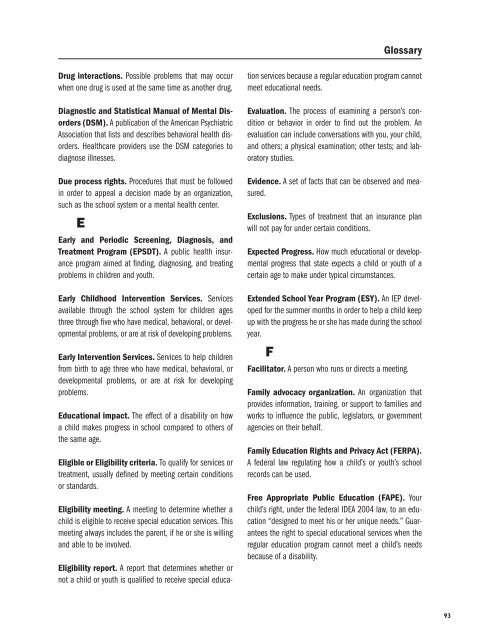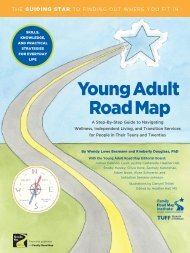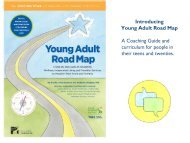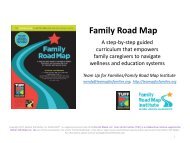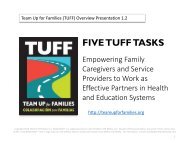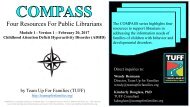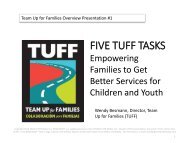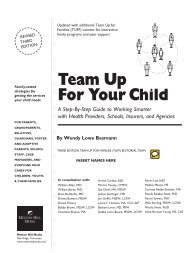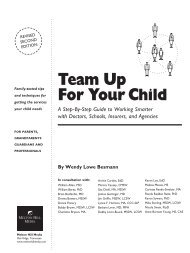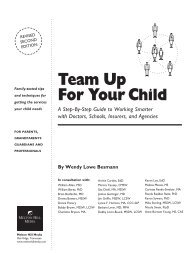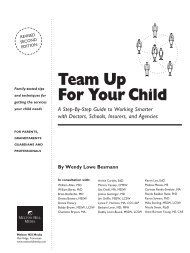Family Road Map Guide
You also want an ePaper? Increase the reach of your titles
YUMPU automatically turns print PDFs into web optimized ePapers that Google loves.
Glossary<br />
Drug interactions. Possible problems that may occur<br />
when one drug is used at the same time as another drug.<br />
Diagnostic and Statistical Manual of Mental Disorders<br />
(DSM). A publication of the American Psychiatric<br />
Association that lists and describes behavioral health disorders.<br />
Healthcare providers use the DSM categories to<br />
diagnose illnesses.<br />
Due process rights. Procedures that must be followed<br />
in order to appeal a decision made by an organization,<br />
such as the school system or a mental health center.<br />
E<br />
Early and Periodic Screening, Diagnosis, and<br />
Treatment Program (EPSDT). A public health insurance<br />
program aimed at finding, diagnosing, and treating<br />
problems in children and youth.<br />
Early Childhood Intervention Services. Services<br />
available through the school system for children ages<br />
three through five who have medical, behavioral, or developmental<br />
problems, or are at risk of developing problems.<br />
Early Intervention Services. Services to help children<br />
from birth to age three who have medical, behavioral, or<br />
developmental problems, or are at risk for developing<br />
problems.<br />
Educational impact. The effect of a disability on how<br />
a child makes progress in school compared to others of<br />
the same age.<br />
Eligible or Eligibility criteria. To qualify for services or<br />
treatment, usually defined by meeting certain conditions<br />
or standards.<br />
Eligibility meeting. A meeting to determine whether a<br />
child is eligible to receive special education services. This<br />
meeting always includes the parent, if he or she is willing<br />
and able to be involved.<br />
Eligibility report. A report that determines whether or<br />
not a child or youth is qualified to receive special education<br />
services because a regular education program cannot<br />
meet educational needs.<br />
Evaluation. The process of examining a person’s condition<br />
or behavior in order to find out the problem. An<br />
evaluation can include conversations with you, your child,<br />
and others; a physical examination; other tests; and laboratory<br />
studies.<br />
Evidence. A set of facts that can be observed and measured.<br />
Exclusions. Types of treatment that an insurance plan<br />
will not pay for under certain conditions.<br />
Expected Progress. How much educational or developmental<br />
progress that state expects a child or youth of a<br />
certain age to make under typical circumstances.<br />
Extended School Year Program (ESY). An IEP developed<br />
for the summer months in order to help a child keep<br />
up with the progress he or she has made during the school<br />
year.<br />
F<br />
Facilitator. A person who runs or directs a meeting.<br />
<strong>Family</strong> advocacy organization. An organization that<br />
provides information, training, or support to families and<br />
works to influence the public, legislators, or government<br />
agencies on their behalf.<br />
<strong>Family</strong> Education Rights and Privacy Act (FERPA).<br />
A federal law regulating how a child’s or youth’s school<br />
records can be used.<br />
Free Appropriate Public Education (FAPE). Your<br />
child’s right, under the federal IDEA 2004 law, to an education<br />
“designed to meet his or her unique needs.” Guarantees<br />
the right to special educational services when the<br />
regular education program cannot meet a child’s needs<br />
because of a disability.<br />
93


